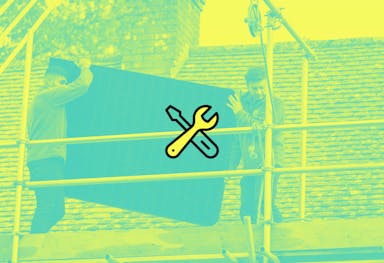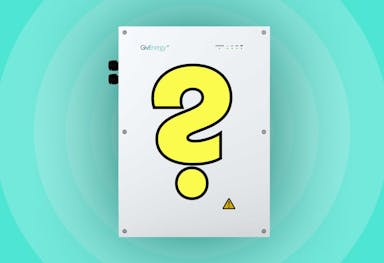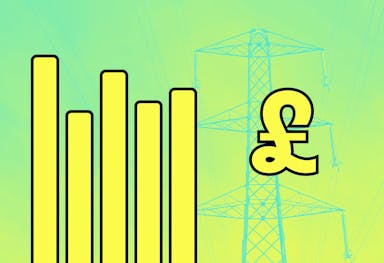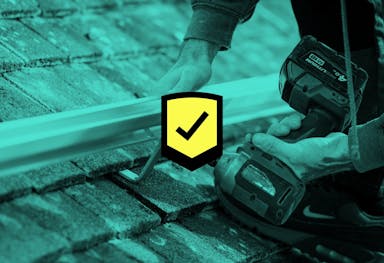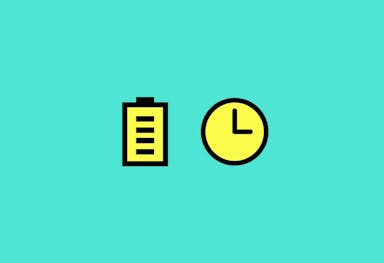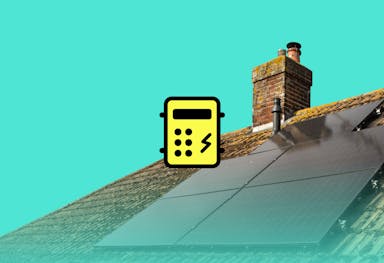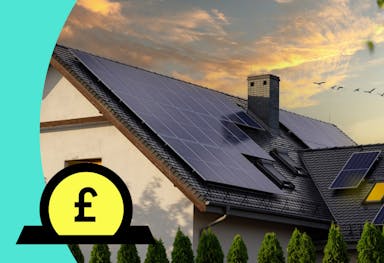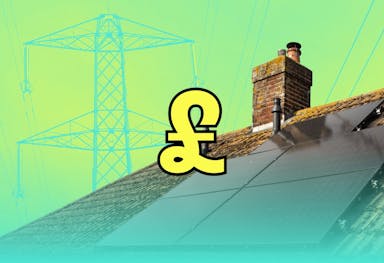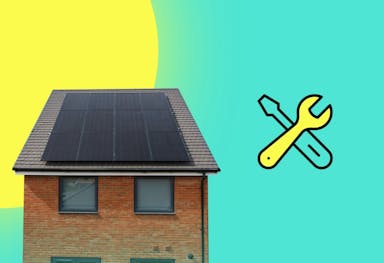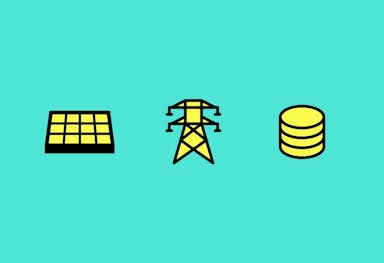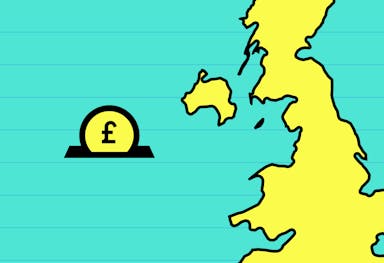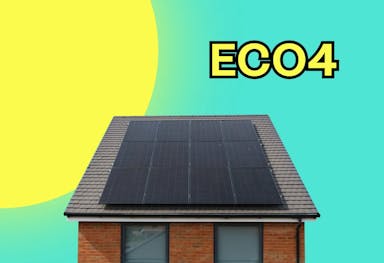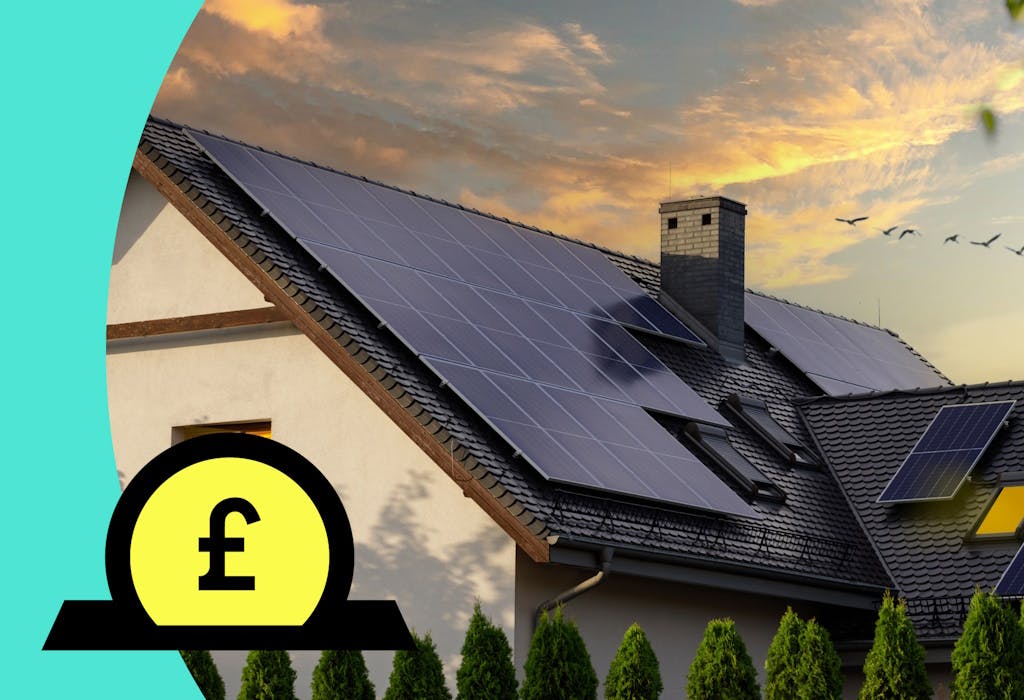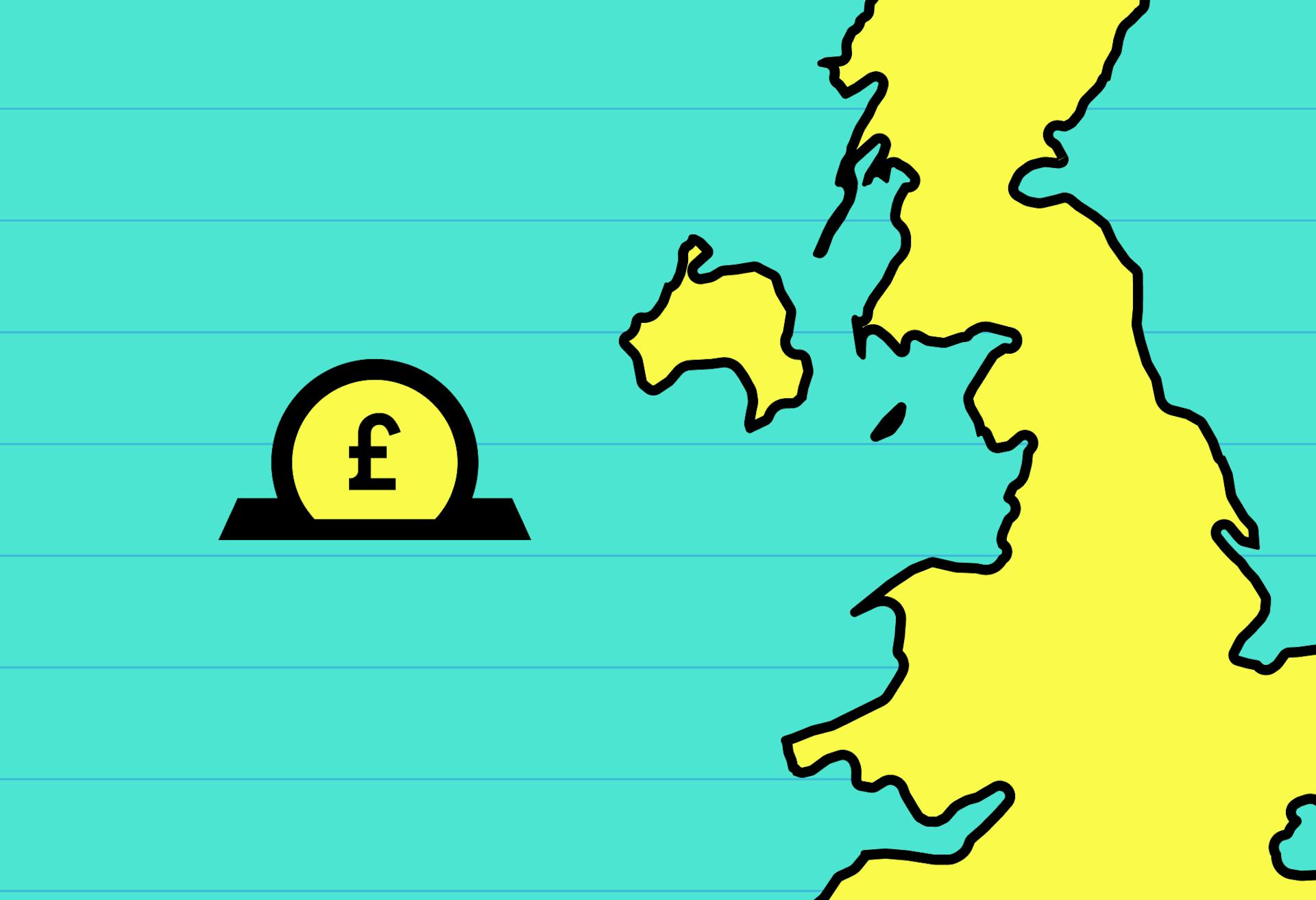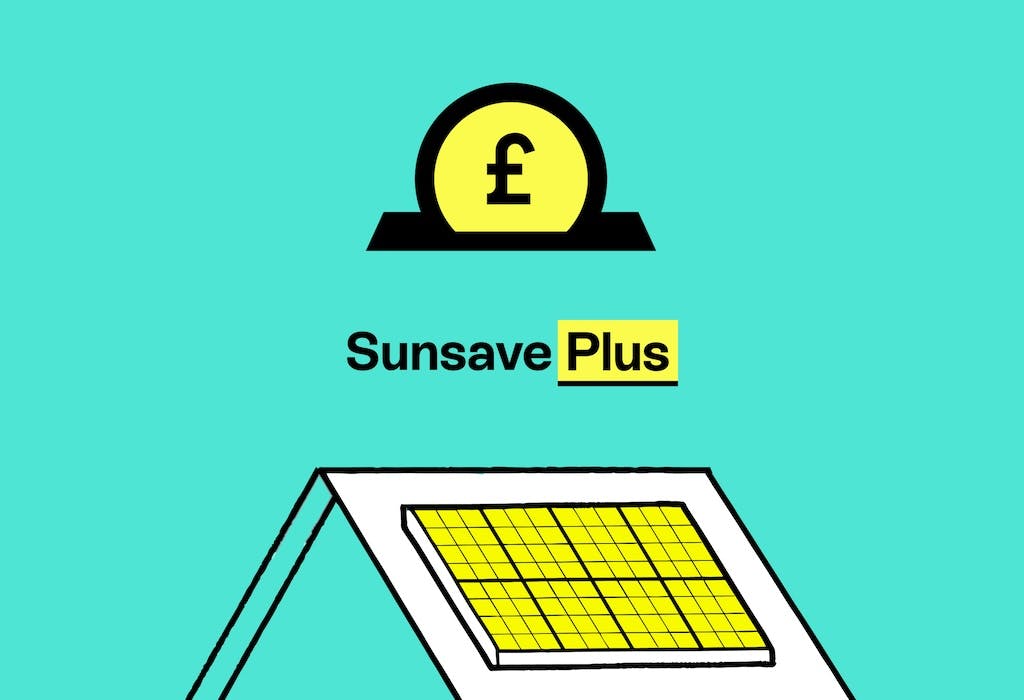- Solar advice hub
- Costs
- How much do solar panels cost in the UK?
How much do solar panels cost in the UK?
Here’s how much solar panels cost, the factors that influence this price, and what to do if the upfront cost is too high.


Why you can trust our content
We know that the solar industry is full of misinformation, but we only use reliable sources, including:
- Our experienced solar experts, installers and system designers
- Our own database of solar & battery system designs
- Authoritative bodies like MCS and the UK government



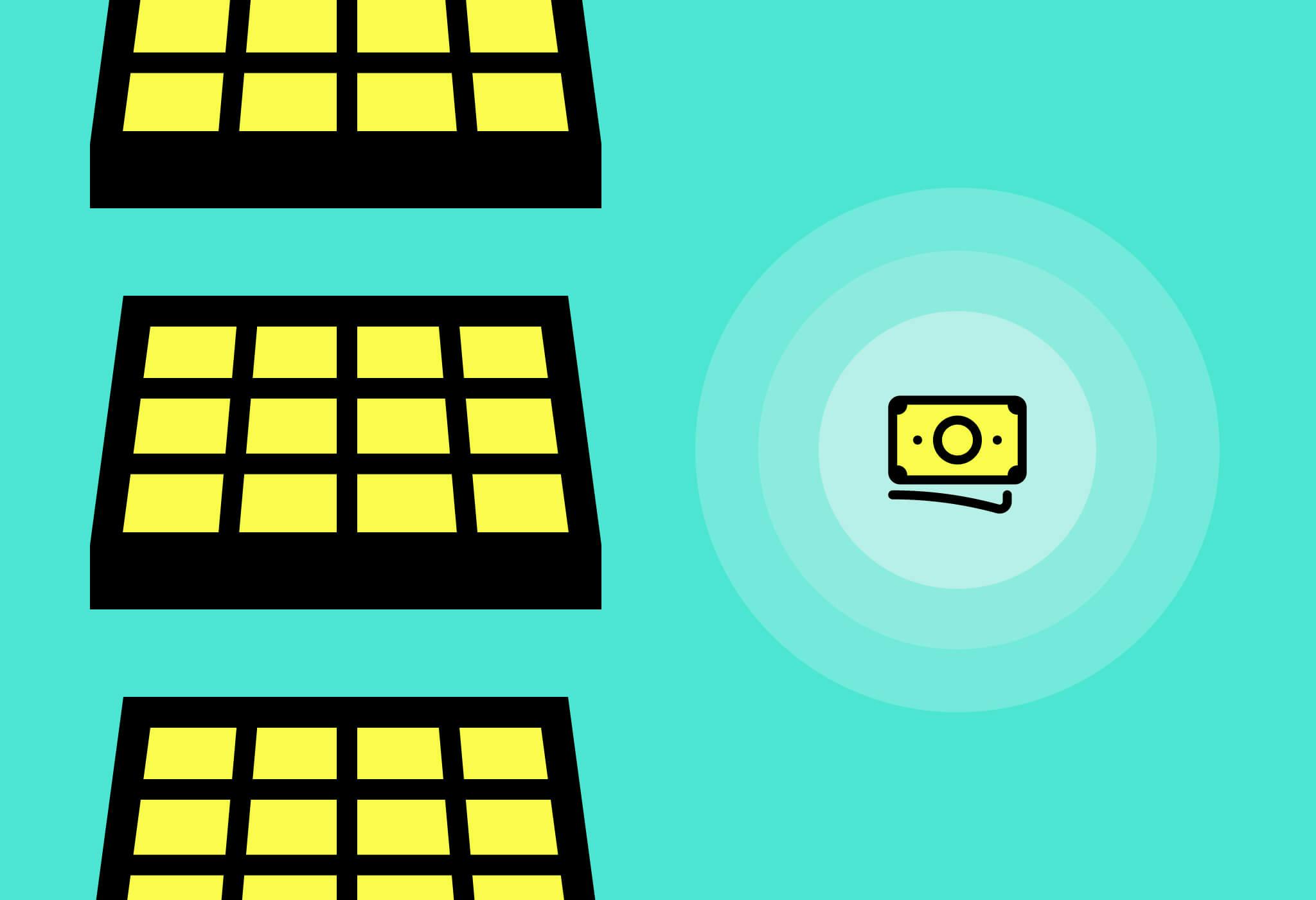
Calculate savings
What kind of home do you live in?
Calculate savings
What kind of home do you live in?
Solar panel costs: at a glance
Solar panels can massively reduce your electricity bills and carbon footprint, while lessening the impact of any energy price rises – but the upfront cost can be a major hurdle.
In this guide, we'll explain how much solar panels cost, how different factors affect the price you’ll pay, and why it's a worthwhile investment for your home and the planet.
If you’re feeling put off by the high upfront cost of solar panels, consider Sunsave Plus, which is the UK’s first solar subscription. It means you can switch to solar with no upfront cost, and instead make completely fixed monthly payments.
If you’re wondering how much a solar & battery system could save you, answer a few quick questions below and we'll provide an estimate.
How much do solar panels cost?
| Property size | Annual electricity usage (kWh)* | System size (kWp) | No. of solar panels (450W) | Estimated cost** | Estimated cost with 5kWh battery† |
|---|---|---|---|---|---|
| 1 bedroom | 1,800 | 2.25 | 5 | £4,743 | £7,743 |
| 2-3 bedrooms | 2,700 | 4.5 | 10 | £8,307 | £11,307 |
| 4-5 bedrooms | 4,100 | 6.75 | 15 | £12,460 | £15,460 |
The average cost of a 4.5kWp solar panel system for a typical property with two or three bedrooms is about £8,307, including installation. This jumps up to around £11,307 if you’re adding a 5kWh battery.
This is a great time to get a solar & battery system, as there’s currently 0% VAT on both panels and batteries.
These costs are of course just estimates, and can vary widely on a whole range of factors, including the size of your system and the complexity of the installation.
Verified expertThere are certain solar panel costs that are ‘fixed’, meaning they generally stay the same regardless of how many solar panels you install. This includes labour, scaffolding, plus your inverter and battery. In many cases, adding a few extra solar panels to your system doesn’t add as much to the cost as you might think, whereas it has a big impact on your savings.
Alfie Ireland
Head of Operations & Technical at Sunsave
Alfie has worked in green tech for over a decade. During his four years at OVO, he helped develop the world’s largest domestic vehicle-to-grid trial.
Solar panel costs per m²
Solar panels cost around £415 per m² on average for a 10-panel, 4.5kWp system, which is typically the best choice for a three-bedroom household.
This is based on each solar panel measuring around 2m².
Since this figure includes installation costs like scaffolding, it drops as you add more solar panels to your project – so however many panels you're planning on buying, you should ideally have them installed at the same time.
Solar panel costs by installation type
A roof-mounted system is the best choice for most households when it comes to costs.
Generally, flat roof installations cost around 20% more than a standard rooftop installation. As your installer won't be able to drill into the roof without creating a high chance of leaks, they'll use ballasts to keep your panels in place.
The additional weight of around 80kg per panel is too much for most domestic flat roofs to bear. It’s also usually very difficult to physically inspect the rafters of a flat roof and make sure it’s structurally sound.
The extra cost is worth it to avoid the price of water damage, but it's almost always better to simply avoid putting a system on a domestic flat roof.
Roof-integrated systems typically cost 18% more than rooftop panels when retrofitted, to pay for the time, skill, and scaffolding it takes to remove the right roof tiles and fit panels flush with the remaining tiles.
Solar tiles cost around 114% more than rooftop panels, mostly because installing them involves replacing an entire roof. This usually takes weeks rather than days, and requires more materials, labour, and scaffolding than a standard job.
Getting ground-mounted solar panels is about 30% more expensive than buying a rooftop system because it takes more time and money to secure panels to the earth, and to do so at the right angle.
You'll also have to apply for planning permission, which you normally won't need if you're getting solar panels on your roof.

Why are solar panels so expensive?
Solar panels are expensive mainly because they require a complex installation process.
This process throws up a large number of associated costs that you have to pay if you want your system to work effectively.
As well as the panels, you’ll pay for materials like the inverter, cables, racks, and potentially a solar battery, as well as for business costs including the labour, scaffolding, electrical expertise, and installer overheads.
These are unavoidable costs. Your roof is usually the best place for your solar panels, and unless you’re certified by the Microgeneration Certification Scheme (MCS) or Flexi-Orb, you shouldn’t install the panels yourself.
You'll save money in the short term, but miss out on major financial benefits, like export income and potentially increasing your home's value. It's also dangerous – one slip or poor electrical connection can be disastrous.
For more information, read our guide to DIY solar panels.
The cost of solar panels over the years, 1975-2023
The cost of solar panels has fallen dramatically over the past few decades.
Customers across the world paid $130.70 (£102.89) per watt in 1975 – meaning a 3kWp system would've cost you £297,750, with all prices adjusted for inflation.
That figure has plummeted by 99.8% since then, with the average global price of solar now standing at just 26¢ (21p) per watt.
This massive drop is due to increased manufacturing capacity, improved processes, increasingly cheap materials, and skyrocketing demand, as the solar panel has evolved from a quirky piece of promising technology to a transformative addition to the energy mix.
Solar is becoming increasingly popular in the UK, and currently more than 5% of the country's households have a solar panel system.
However, this long-term decline in solar panel costs looks like it's flatlining, and potentially starting to increase. You can find out more in our article: Will solar panels get cheaper?

The UK's first solar subscription
- No upfront cost
- Fixed monthly fee
- 20-year Sunsave Guarantee
What factors make up the cost of solar panels?
The biggest factor in determining the cost of your solar panels is usually labour and scaffolding, as you can see in the chart below.
Solar panel cost breakdown, 2024
As you can also see in this chart, there are plenty of other important – and costly – parts of a solar panel installation.
Let's go into more detail about each factor.
1. Labour and scaffolding
In most cases, the biggest single contributing factor to the total cost of a solar panel installation is the labour and scaffolding.
This cost can vary significantly, depending on how accessible your roof is. The harder the roof is to reach, the more expensive the scaffolding setup becomes.
Adding a few panels to your system rarely makes a huge difference to cost, but if your scaffolding changes from something routine to something highly specialised, this can add thousands of pounds to the overall price.
For example, the scaffolding needs to rest on the ground, and if there's a low roof in its way (e.g. from a conservatory or extension), your installer may need to 'bridge' over it, which makes the project more complex and expensive.
At the same time, you may also pay more if your scaffolding is on the larger side, or if the installers have limited access to your home – for instance, if it’s a terrace house.
There are also specific roof features that can make the layout of your panels more complicated, which can mean more railings, and therefore a higher price.
These features include:
- Velux windows, also known as skylights
- Chimneys
- Pipes, e.g. soil vent pipes or flue pipes
- Dormer roofs
- Gable roofs
For more information, check out our guide to how solar panels are installed.
And read our article on roof suitability for solar panels to learn more about whether your home is right for solar.
2. Battery storage
The next biggest chunk of the total cost is usually the battery hardware.
Opting for battery storage adds around £3,000 to the overall price, although it can be more than this if you choose a larger battery (i.e. 10kWh or more).
However, a battery is well worth it, as it provides several excellent benefits.
Without a battery, all the electricity your solar panels generate must be used at the moment it’s created, otherwise it’s automatically sold to the grid. This makes it tricky for people who aren’t home much during the day to actually make use of their solar panels.
With a battery, any electricity you don’t use instantly is stored, ready to be called on after the sun goes down. A battery also gives you access to some of the best solar export tariffs.
It's also possible to get a storage battery that can provide emergency power during outages, although we generally don't recommend this.
EPS for solar is rarely necessary in the UK, because the typical home is barely affected by power cuts, if at all.
The average household experiences 0.4 outages per year, and loses electricity for around 35 minutes in total, according to an Ofgem report.
3. The number of solar panels
Another deciding factor behind your system's cost is the number of solar panels.
The more solar panels you buy, the higher the price tag, as you'll have to pay for more brackets and possibly a larger inverter – as well as a potentially bigger solar battery, if you get one.
However, more panels also means proportionally more savings, since most of the associated costs of installation – like scaffolding, labour, and vehicle expenses – don't typically increase by as much as the amount an extra solar panel will save you.
For that reason, it's generally worth maximising the space on your rooftop and getting as many solar panels as possible.
To find out how much a solar & battery system could save you, fill in a few details below and we'll provide an estimate.
4. Solar panel type and quality
The two most common types of solar panels are monocrystalline and polycrystalline, and your choice will affect the overall cost. It’ll also affect your system’s efficiency – that is, the proportion of the light that hits your panels that can be converted into electricity.
Monocrystalline panels are more expensive but have a higher efficiency of up to 25%. As each panel is made from a single silicon crystal – hence ‘mono’ – these panels have a black colour and sleek appearance.
Polycrystalline panels are no longer being made, according to the National Renewable Energy Laboratory.
You'll still find them on roofs, with efficiency levels of around 15%, and some installers still buy them second-hand. They're made from several blended silicone fragments, so have a speckled, blue-tinged colour, and a slightly less glossy appearance.
However, even if you settle on getting monocrystalline panels, these can obviously range in quality. Some are far more efficient and more powerful than others, which will have an impact on cost.
5. Inverter type and quality
A standard string inverter that’s responsible for the entire solar panel system is usually less expensive than microinverters, which are installed on every single panel.
Microinverters will ensure that your system is more efficient, but there’s a significantly larger initial cost.
In total, it'll typically cost you around 20-30% more to get microinverters rather than a string inverter.
Verified expertFor roofs with significant amounts of shading, microinverters are a much more sophisticated solution than optimisers. They’re about three times the price of optimisers, but you save on not having to buy a string inverter. You also get what you pay for; microinverters will significantly increase the amount of electricity your system can generate.
Alfie Ireland
Head of Operations & Technical at Sunsave
Alfie has worked in green tech for over a decade. During his four years at OVO, he helped develop the world’s largest domestic vehicle-to-grid trial.
6. Racking
Racking is the network of clamps, flashings, mounts, and rails that will securely hold your solar panels for the next few decades.
Considering its importance to your system, racking makes up a small proportion of the total cost of your installation, at just 7%.
This means an average household will typically pay between £600 and £1,000 for racking, though your total will depend on the number of panels, the shape of your roof, and the type of roof tiles you have.
Slate tiles, for instance, make for a trickier racking process – but the right installer will ensure your panels are fitted safely while leaving your roof intact.
7. Local delivery & logistics
If an installer has to travel relatively far to get to you, they'll charge you more, so you should generally choose a local installer.
Installers don't tend to take jobs that are especially far away, as it raises their costs.
This in turn means they have to increase their prices – which makes them uncompetitive against local alternatives.
8. Accreditations & DNO approval
Accreditations are a strong indication that your installer will do a good job.
They're often baked into the prices offered by trustworthy installers, meaning you might pay more – but when you're making a significant change to your home in order to save hundreds of pounds every year for decades, it's worth the extra initial cost.
A good installer will also handle your G98 or G99 application for you.
If your inverter’s maximum capacity is less than 3.68kW on a single-phase system, your installer can move ahead without getting approval from your region's Distribution Network Operator (DNO), which runs the hardware that provides your area of the UK with electricity.
They'll then send a completed G98 form to your DNO within 28 days of switching on your system.
However, you or your installer must submit a G99 application to the DNO if your inverter’s maximum capacity is more than 3.68kW per phase.
This application makes your DNO aware of the system, so it can take the extra electricity into account while running its part of the grid.
DNOs generally accept G99 applications, but not always – and a rejection can lead to increased costs if more work is required.
For instance, if you need to switch your home to three-phase electricity to get your G99 approved, it’ll cost around £5,700.
Verified expertIf your inverter is larger than 3.68kW then you will need DNO approval, but Sunsave will take care of everything. We’ll apply for the G99 on your behalf, and if the grid requires, we can limit export from your inverter at the point of installation - so you can use its full power at home, whilst still meeting the export requirements of the grid.
Alfie Ireland
Head of Operations & Technical at Sunsave
Alfie has worked in green tech for over a decade. During his four years at OVO, he helped develop the world’s largest domestic vehicle-to-grid trial.
How much money do solar panels save you?
On average, you could save 86% on your electricity bills with a solar & battery system.
This figure is based on a sample of over 150 systems installed by Sunsave across England and Wales in 2024. The average system is 6.1kWp, with 54% of solar electricity used at home and 46% exported to the grid.
To learn more, read our guide to how much solar panels could save you on your energy bills.
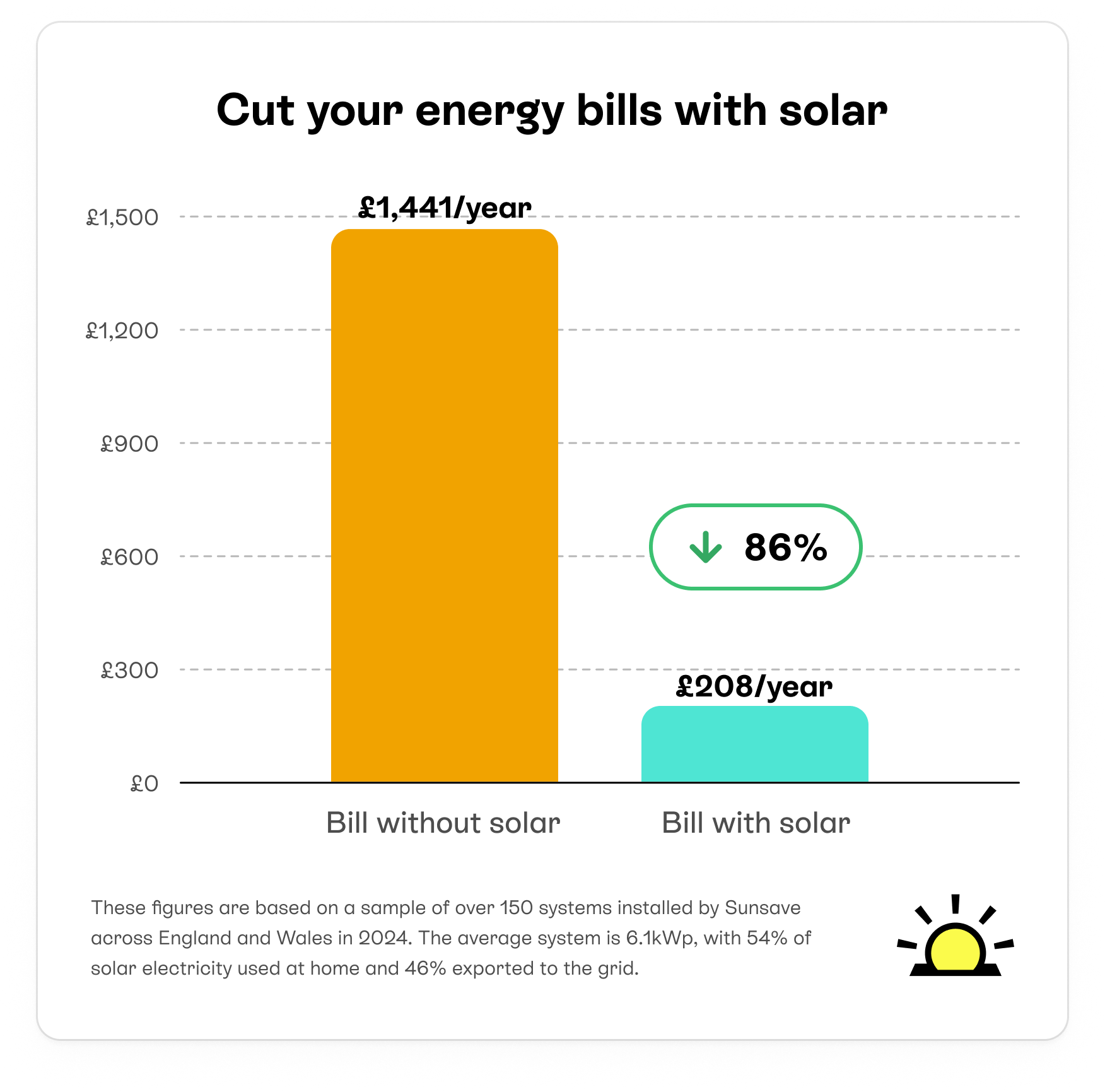
What solar export tariffs are available?
Here are the top 10 highest-paying solar export tariffs available right now, excluding tariffs that require you to use a specific installer.
To get the full lowdown, check out our vast guide to the best SEG rates, which also shows which import tariff goes best with each export tariff.
| Provider | Tariff | Export rate (p/kWh)* | Customers only? |
|---|---|---|---|
| Octopus | Intelligent Octopus Flux †† | 4pm-7pm: 30.69 Other times: 23.02 |
Yes |
| Octopus | Octopus Flux | 2am-5am: 4.99 4pm-7pm: 29.32 Other times: 10.11 |
Yes |
| E.ON | Next Export Exclusive | 16.5 | Yes - or install with E.ON |
| British Gas | Export and Earn Plus | 15.1 | Yes |
| Octopus | Outgoing Fixed | 15 | Yes |
| Good Energy | Solar Savings | 15 | Yes |
| EDF | Export 12m | 15 | Yes |
| ScottishPower | SmartGen Premium | 12 | Yes |
| OVO | SEG Beyond Exclusive | 12 | Yes |
| Utility Warehouse | UW Smart Export Guarantee - Bundle | 8 | Yes |
Verified expertThe best solar export tariff for your household depends on a few factors. For instance, if you have a heat pump and/or an electric car with your solar panels, it could be worth considering an export tariff like Octopus Outgoing and combining it with import tariffs like Octopus Go or Cosy Octopus. At Sunsave, we’ll always recommend an export tariff that’s best for you.
Alfie Ireland
Alfie Ireland
Alfie has worked in green tech for over a decade. During his four years at OVO, he helped develop the world’s largest domestic vehicle-to-grid trial.
How long do solar panels take to pay for themselves?
On average, you could break-even on your solar & battery system in just over eight years.
This figure is based on a sample of over 150 solar & battery systems installed by Sunsave across England and Wales in 2024.
The average system size is 6.1kWp, with 51% of solar electricity used at home and the other 49% exported to the grid, on average.
Your payback period can rise or fall, depending on multiple factors. These include the initial cost of the system, the panels’ electricity generation, local electricity rates, and the export tariff.
This is also just an average – your system's break-even point will depend on how much energy solar panels can produce on your roof, so it may be considerably shorter if you live in a sunny location and own a roof that's well-suited to solar panels.
Here are several solar & battery systems we’ve designed, with their different payback periods.
If you’d like to learn more, read our guide that explains how long solar panels last after their break-even point.
Verified expertAny household appliance that heats or cools should be used as efficiently as possible to keep running costs low. Some of the most energy-hungry everyday appliances include washing machines, tumble dryers, dishwashers and EV chargers. If your home has solar panels, these are the things to use in the middle of the day when you’re generating the most energy.
Dr. Steve Buckley
Energy Doctor and Head of Data Science at Loop
With a background in statistics and data science, Steve is in charge of product direction at Loop and has worked at multiple successful startups.
Solar with heat pumps and EVs
Powering your heat pump and electric vehicle with electricity generated by your own solar panels is a fantastic way to save money on your heating and transport costs.
Unless you're on a solar export tariff which charges exactly the same rate for imports and exports (such as Intelligent Octopus Flux), consuming the electricity your panels produce is usually better than sending it to the grid, since other tariffs don’t offer identical import and export prices.
And using your own solar generation is much easier to do when your heating and car run on electricity – though of course, this approach does require you to pay for a heat pump, electric vehicle, and EV charger.
Purchases of both technologies are rising rapidly though, as homeowners move to save money on their energy and fuel bills, while also cutting their carbon footprints.
Verified expertIf you’re thinking about electrifying your heating by switching to a heat pump, solar panels are a no-brainer. A heat pump will dramatically increase the amount of electricity your household uses, but solar panels can step in and provide a big chunk of it. You also don’t need to get a specific, “solar-compatible” heat pump - all heat pumps work with solar panels.
Alfie Ireland
Head of Operations & Technical at Sunsave
Alfie has worked in green tech for over a decade. During his four years at OVO, he helped develop the world’s largest domestic vehicle-to-grid trial.
How to keep the costs of solar panels down
Here are a few ways you can switch to solar without paying such a high upfront cost:
- Look into solar panels without an upfront cost
- See if you’re eligible for a government grant
- Check out your local Solar Together scheme
- Avoid used solar panels
Look into solar panels without an upfront cost
You can get solar panels at no upfront cost with a subscription like Sunsave Plus, which offers all the benefits of going solar without the burden of the initial payment.
With Sunsave Plus you’ll get best-in-class kit, all in one easy package that works seamlessly, looks excellent, and can save you money from day one.
Sunsave Plus also comes with the 20-year Sunsave Guarantee, which provides monitoring and maintenance, a free battery upgrade and inverter replacement, and downtime payments if your system doesn’t work.
Your system will also be insured by Aviva against damage, fire, and theft.
Other ways to get solar panels with no upfront cost include solar roof leases, solar panel leases, and some solar panel loans - but they all come with key drawbacks that we explore in each of the articles we've linked to.
See if you’re eligible for a government grant
There are several grants and schemes on offer which can help with the cost of solar panels.
For instance, schemes like the Energy Company Obligation (ECO4) focus on improvements to energy efficiency for low-income households and some social housing tenants.
The Warm Homes: Local Grant and PPA schemes also offer other forms of financial support, making solar installations more accessible for certain groups of people.
Click the button below to find out if you could be eligible for a solar panel grant.
Check out your local Solar Together scheme
Check if your local area has signed up for the Solar Together scheme.
This community-based programme negotiates group discounts for solar panel installations, making them more affordable for individual homeowners – though you’ll still need to pay an upfront cost.
To find out more, read our full guide to Solar Together.
Avoid used solar panels
Second-hand or used solar panels are always attractive to cost-conscious customers – but buy these at your peril.
Purchasing them will usually just kick the cost further down the line, since low-cost panels that other people don’t want will almost always be less efficient, less effective, and less durable.
This means you probably won’t break even on them, and will end up buying another set of panels before too long.
If you’re investing in your future, you should do it with high-quality equipment.
If you get a cheap quote from an installer, you should ask these important questions before making your final decision.
The hidden costs of going solar
Solar & battery systems come with a high upfront cost in the UK, but it's not just the initial price of the panels, battery and labour that homeowners need to consider.
Across a system’s lifetime, there are various maintenance requirements that lots of installers don’t talk about, including expensive hardware replacements.
Here are the five hidden costs of switching to solar.
1. Replacement battery
A battery can dramatically improve your energy bill savings with solar; you can use more of your solar electricity, access the best export tariffs, and benefit from time-of-use import tariffs.
However, batteries slowly deteriorate, and they usually need replacing after 10-12 years, otherwise you’ll no longer be getting the best out of your solar panels, which can last 30-40 years.
Most solar installers won’t tell you about this hidden cost, so be sure to factor this into your calculations.
Our solar subscription, Sunsave Plus, comes with the Sunsave Guarantee: a comprehensive maintenance package that includes a free battery upgrade.
2. Ongoing maintenance
Solar panels are built to last, but that doesn’t mean things don’t still go wrong, and it’s easy to miss problems if you’re not an expert.
What’s more, issues that go ignored can lead to much bigger problems further down the line, which means reduced output and smaller savings. If a panel needs repairing or replacing, it will require an engineer, and potentially also expensive scaffolding.
Most installers just offer a basic workmanship warranty for the first two to five years, but the Sunsave Guarantee lasts for 20 years, and it includes 24/7 monitoring, maintenance, replacement parts, and insurance.
3. Replacement inverter
Every solar system relies on an inverter, which converts electricity from DC to AC.
However, according to a 2019 study by DNV, one half of inverters fail by year 14, at which point they need replacing. If you don’t sort out a broken inverter, you’ll no longer be able to use or export any of your solar electricity.
The Sunsave Guarantee also includes a free inverter replacement, which saves our customers the cost and hassle of having to sort this out themselves.
4. Bird protection
Birds (mainly pigeons!) love to nest under solar panels, cause a lot of mess, and peck at the wiring, leading to a drop in output and reduced savings.
This can involve very expensive repairs, as well as a pretty thorough clean-up job. Spikes or mesh placed around the edges of a solar array are very effective at keeping birds away, and any good installer will be able to do this for you.
However, it’s best to get this installed at the same time as your panels, as doing it later could involve having to pay for scaffolding all over again.
To learn more, check out our full guide to solar panel bird protection.
5. Optimisers and microinverters
Even if just one or two solar panels are in significant shade for a decent chunk of the day, this can affect the output of the whole system.
Optimisers and microinverters are small devices that can help solar panels deal with this problem, although the added benefit doesn’t always outweigh the additional cost.
Before recommending either, a good installer will first try to overcome the problem by using smart system design.
For example, they can place the shaded modules on a different ‘string’ of the inverter, which prevents them from dragging down the output of the other panels.
Next steps
In the great majority of cases, solar panels come at a high upfront cost, with households spending thousands of pounds before they can start saving.
It's definitely worth the investment, as solar panels can help you cut your electricity bills by hundreds of pounds per year, recoup their initial cost decades before they stop producing electricity, and potentially raise your home's value.
But if you can’t afford the upfront cost of a solar & battery system, you can still switch to solar.
Sunsave Plus is our solution to this problem, as it provides you with best-in-class kit with no upfront cost - instead, you pay a fixed monthly fee for 20 years.
If you would like to see the savings you could get from a solar & battery system, just answer a few quick questions below and we’ll provide an estimate.
Solar panel costs: FAQs
Related articles

Written byJosh Jackman
Josh has written about the rapid rise of home solar for the past six years. His data-driven work has been featured in United Nations and World Health Organisation documents, as well as publications including The Eco Experts, Financial Times, The Independent, The Telegraph, The Times, and The Sun. Josh has also been interviewed as a renewables expert on BBC One’s Rip-Off Britain, ITV1’s Tonight show, and BBC Radio 4 and 5.
